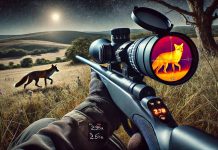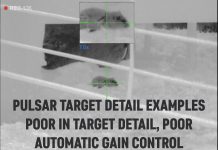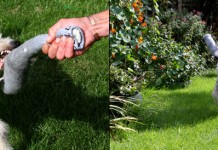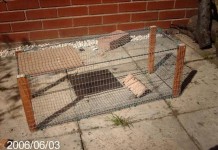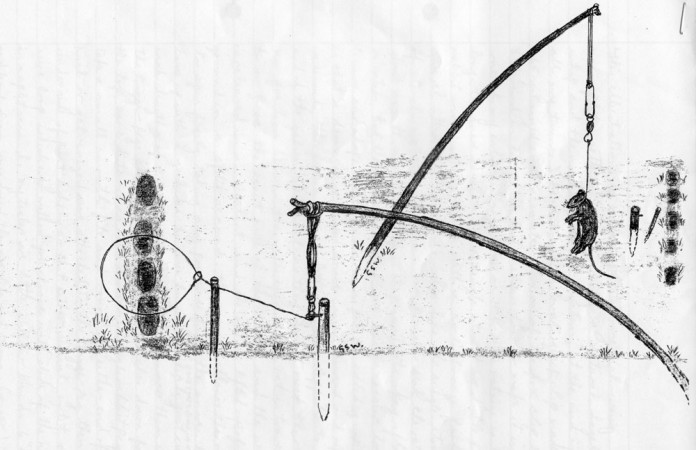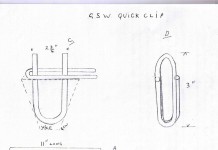What you see here in this illustration is a rat snaring system that I used over a number of years. The snare consists of a 12 inch length of fishing trace wire 65lbs breaking strain. It was brown in colour, thin almost invisible when set but extremely strong and very reliable. The eye was just a small picture hook and held very well, it was very effective. At the end of the snare a large bronze of stainless steel fishing swivel was attached. The tealer was a natural willow wand six inches long, pointed at one end to insert into the ground the top is flat with a small slot across the top to hold the snare loop in position over the rat run. To secure the whole system a length of 3 mil gabranized fencline wire 12″ long and bent into a tight U shape then inserted through the end eye of the swivel secured the whole system. It was simple and very effective. I mostly used it in gardens where rats were crossing over lawn travelling to and fro from a neighbours bird table, on occasions I have sat and watched them getting caught in the snares. The securing loop can be made longer id so desired, but 6 inches is more than enough especially on runs crossing a firm lawn. Don’t use brass snare wire with this system or the big rats will chew through it with relative ease. Although I knew of the rat spring snaring method consisting of the hazel whip and trigger peg system I never really bothered with it, until a few years back when Peg and Gum came up to stay for a few days and brought a couple of dozen hazel whips with him. The hazel whips or bender are extremely effective and was a great cheap and very cost effective method in controlling farm yard, and countryside rats. It was also good fun and I have continued to use the spring snaring system ever since. A word of caution it is most advisable to wear rubber gloves when rat snaring, as rats can harbour various life threatening diseases.

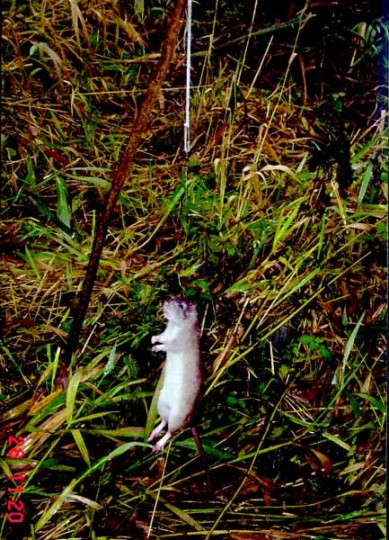
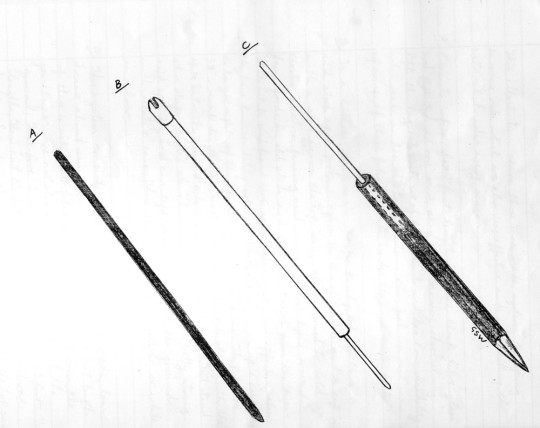
This illustration above shows three man made systems for spring snaring which are very effective and saves cutting the natural benders every season.
A. Consists of a four foot length of 6 mil black fibre glass rod pointed at one end, very light to carry and also strong, lifts the big rats well up of the grounds and has low visibility when set in the catching position. Alan Salmon sent me up some of these poles he trades under the name “Master Hunter”
B. Its a hollow half inch plastic bendy pole, with a 4 inch steel spike protruding from the base of the pole and a cap with a slot across the top. These poles are used to hold up plastic electric net fencing and can be found lying around farm yards and old sheds and lofts. I got some from the keeper at the estate and found them quite lighter to carry and effective, also they have low visibility when set. Woodga brought me up a couple of dozen as he got a pile of them from a farmer friend of his. The poles are 30″ overall length, you must push part of the pole along with the spike into the ground when setting them and they must stand at a steeper angled elevation. Once set they are pretty strong and springy and can lift heavy rats up of the grounds with relative ease. These poles are usually yellow or white in colour.
C. This system consists of part naturals and man made, How I came about using this method was that the five foot lengths of these 4 mil white fibre glass poles that I got from the game keeper where not strong enough to lift rats of the ground. Therefore I cut them in half into 2.5 foot lengths then I cut the bottom half off my old natural hazel whips from the previous season. I drilled the top end of these two foot long hazels to a depth of six inches then glued the ends of the fibre glass rods and inserted them into their hazel bases. These benders are also set at a slightly more elevated position and work very well. To help conceal these three latter man made systems, I spray them all with Vauxhall leaf green auto paint and it blends these into the natural surroundings extremely well, hiding them from prowling purring eyes.
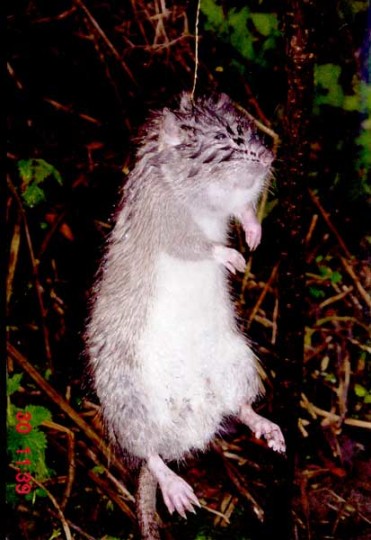
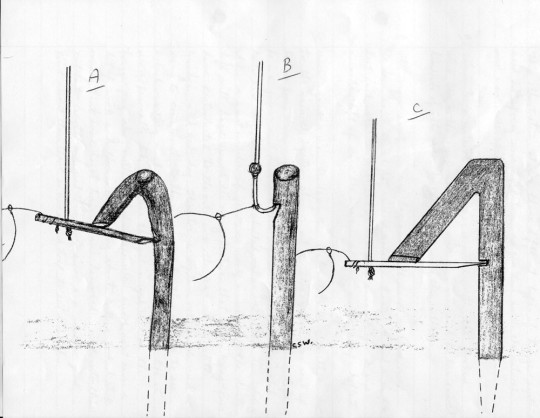
This illustration shows three different types of trigger systems used in the spring snaring of rats in conjunction with the natural and man made spring systems.
A. Illustrates a natural trigger peg system with the forked stick. This is the system that Peg and Gun uses and he has snared hundreds of rats over the last 20 years using this method.
B. This trigger system is another and well used method over the decades, a natural peg with a notch cut into it and a simple bent nail with the point cut off and filed smooth for a nice smooth lift of once the snare is sprung its simple cheap and effective.
C. Once again a man made system that works very well, similar to the natural system shown at A. This system was set up to me from Duckwing who also is a member of Hunting Life he is a joiner and constructs these systems. He to, is very proficient and skilled rat snarer that’s been doing it for a great number of years. As many members of the Hunting Life, will have viewed the many pictures that he, Peg and Gun have contributed to the site over the years along with Woodga and Red Dog. These trigger systems are simple and easy to construct, so the viewers can try these systems to see which one they most prefer to their liking and if you like it, use it. I personally like and use the galvanized nail on the trigger peg along with the fishing swivelled snare, as it saves a lot of work and there is no fiddling about cutting forked sticks. One day I cut some hazel triggers and hammered nails into them, cut them into length and used them ever since and another good point about them, there is no wind trip to set them off.
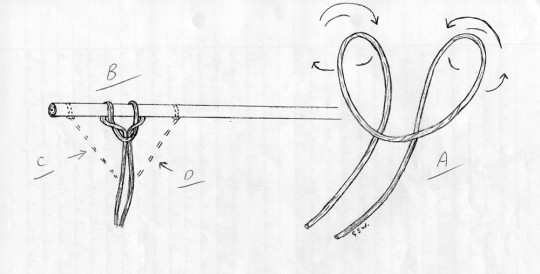
A. This illustration shows a double loop system that I personally use on my twine when attaching it to a natural or man made spring pole when snaring rats. This simple loop system can help you set your benders allot quicker and saves having to pull the bender or whip in and out of the ground until you have it hanging above the trigger peg so that the twine hangs down in a vertical manner ready to attach to the trigger system. The loops shown in the illustration is the same method employed by the old rabbit trappers to attach the twine to their notched rabbit pegs. If looped around the peg as seen, the loops would slacken off, therefore if you turn the loops around as arrows show and put them back to back then slip them over a peg or a pole, pull them in firmly they will now hold firm and tight and they wont come loose.
B. Showing the loops slipped onto bender before pulling them in tightly together.
C. Shows bender twine over lapping trigger peg this is no good as the spring pressure from the bender will fire itself off.
D. Should the twine lie back at this angle from the trigger peg the rat may no be able to pull the trigger system free to release the swivel and allow bender to spring up wards. Therefore the twine loops can slide an inch or two either way forwards or backwards into the vertical position required without having to move or adjust the bender. When using smooth fibre or plastic poles certain twines may slip slightly on the pole or cut a band from an inner bicycle tube and figure 8 it onto a pole and over twine to hold it in place, again twine can be pulled either to or fro to hang in a vertical position from the bender to the trigger peg.
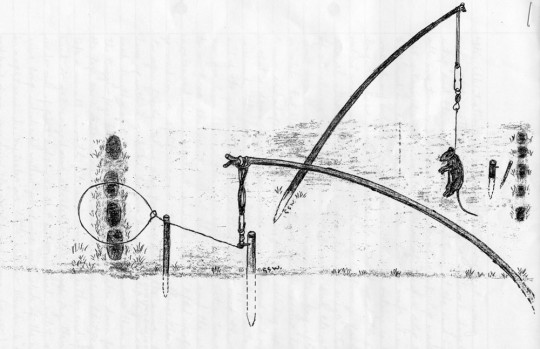
This illustration is self explanatory, showing a complete setting system using a natural hazel whip and the nail and trigger system. At the end of all my twins I have a simple oval quick clip made from 1.65 galvanized wire, a smaller version of the fox clip that I devised in the 70’s in fact it shows how to make it in one of my earlier illustrations on Hunting Life. The rat size is 1 ¼ inches large. The snare consists of a single strand or double strand rabbit snare wire .455 diam with a number 4 bronze fishing swivel attached at the end. I also like the single strand of stainless steel wire of a similar diameter and the rats don’t bite through this stuff, it shapes and sets okay after a catch, but the brass is more pliable and for easier to tension and shape the loop. The reason for the added quick clip is that a damaged or kinked snare can be removed and replaced in seconds. The fishing swivels bottom eye is slipped onto the end of the galvanized nail, as they do not rust there is no friction between them, therefore if the rat is travelling to or fro the least pull of the snare and the whip is released in an instant and the rat is lifted up off the ground in a split second. The swivel allows the rat to spin freely taking any pressure from the snare. Woodga came up with a good idea to save buying nails he must have scots blood in him ha ha. He just cuts inch lengths of 2.5 galvanized wire, and hammer them into the trigger pegs about one and a quarter inches down from the top, same distance as holes drilled through rabbit pegs. Take a small smooth file and round of either end of the nail or galvanized wire, attached to the trigger peg then file under side of point lightly so that either swivel , eyelet or wire loop which ever method you choose will slide of the nail in a split second. My tealers are little willow wonds 6″ long and 4 mil diam, once dried they are light and strong.
A. Set your snare loop a good 2″ off the ground to the bottom loop
B. Set snare loop directly over the middle of a beat the same as setting a rabbit snare.
C. In slightly higher grass where beats can be 4 to 5 inches apart, make a noose bigger and set higher around 3 inches.
D. Once again don’t set on un angled beat set on a straight line
E. Clear any weeds overhanging vegetation away from snare location as the rat could tangle around or climb up any weeds and bite through wire or twine.
F. I cut my trigger pegs minimum 10″ long as the ground is sometimes softer around certain locations where there are a lot of rats.
G. When Setting rat snares around pheasant feeders especially near game crop, keep the snares out on the runs away from the feeders as flocks of little finches feed around these locations and can knock your snare loops off centre, also roe deer come around to eat the grain and bump your benders and set them off. Natural benders or whips can be cut from hazel, ash, rowan, silver birch, holy, privet etc. My own preference is hazel and ash, the silver birch saplings are also strong. I cut mine in December when the sapis down and the grain is tight, it is suprising the power in these natural benders when set, therefore watch your face when setting them as they spring up with good force if accidently knocked.
H. A little safety trick that I used to stop the whip or bender springing up when I set the rat snares is to push the bottom swivel eye along the trigger nail, tight to the side of the trigger peg, when the snare is set in position, I put the tip of my fore finger over the front of the trigger nail then I slide swivel eye along the nail until it sits right under the smooth tip of the nail, ready to fire immediately once the rat hits the noose.
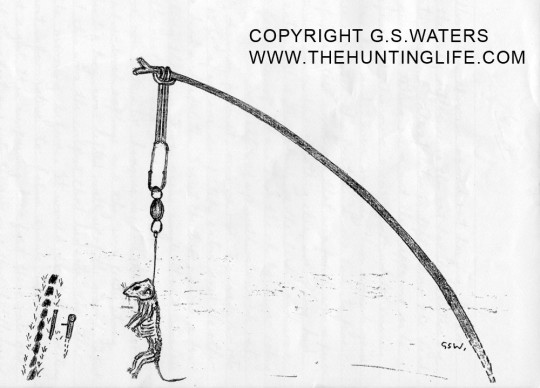
This illustration shows a snared rat hanging from a bender, the only difference is this rat has been eaten by other rats, and only the skeleton is left below the head peg. Peg and Gun was telling me about this happening as he had experience d this over many years while snaring around rats, when him and I where snaring them around game crop we experienced this first hand, one had its face eaten off, in another snare all that was found was a piece of skull and some whiskers, nothing else. Everything had been eaten. I think they climb up the bender and come down from the top. I have had a cheeky bugger eating partly through my bender half way up with a snared rat already hanging from it, on one run I snared two rats about 10 foot apart, one completely eaten and the other only the head and skeleton. I reset the two snares a few feet along the run. I was using a single strand stainless steel, the next morning there was a huge boar rat 15.5″ from nose to tail tip hanging died in the wire. I was using silver burch saplings and they where pretty strong and this big boy was lifted well up off the ground. I took it that this was the culprit that had eaten the other two the morning before. It would be very interesting and most informative to film events like this with a night sight. It is suprising how fast these rats get lifted off their feet and into the air once they hit the snare as I have witnessed this on numerous occasions when checking them in the morning. A bender will fly up into the air and the rat squeals as he is airborne. Rats are neopholic but they never seem to get wise to the simple wire snare. Remember its the simplest offsets that takes the most worry of predators.




